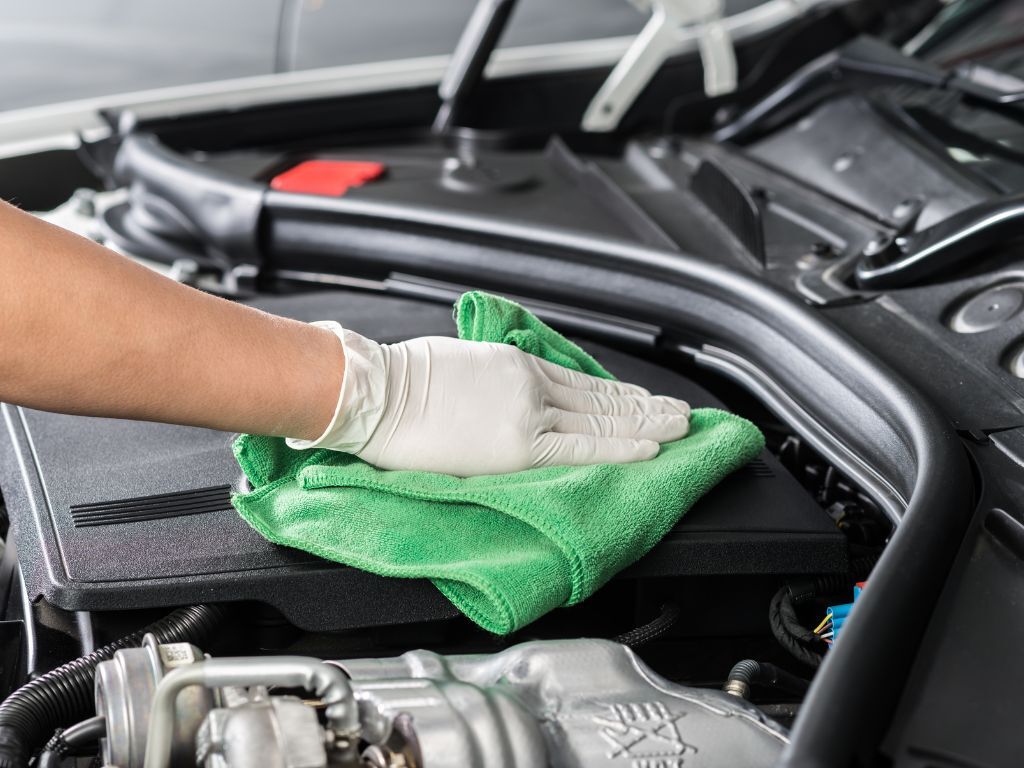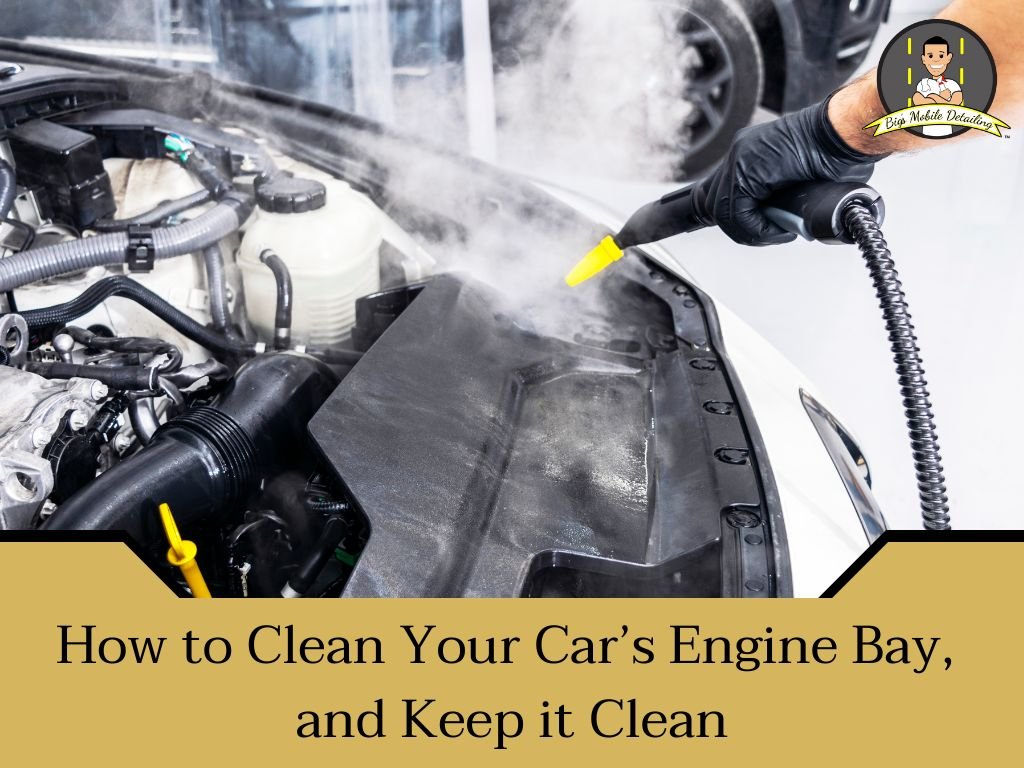Imagine opening the hood of your car and seeing a sparkling clean engine bay. It’s not just a dream—it’s something you can achieve with a little effort.
A clean engine bay not only looks impressive but also helps maintain your car’s health by preventing grime buildup and spotting issues early. Are you ready to give your vehicle the care it deserves? In this guide, we’ll walk you through simple steps to clean your car’s engine bay safely and effectively.
By the end, you’ll feel confident in keeping your car’s heart as pristine as the rest of it. Let’s dive in and transform your car’s engine bay from grimy to gleaming!
Why Clean Your Engine Bay
A clean engine bay prevents debris buildup and improves performance. Regular cleaning helps spot leaks and wear early. It maintains your car’s value by keeping components in good shape.
Cleaning your engine bay might seem like a task reserved for car enthusiasts, but it holds value for every car owner. A clean engine bay isn’t just about aesthetics. It can actually impact the longevity and performance of your vehicle. You might wonder why it’s necessary. Let’s delve into the reasons.Enhance Vehicle Performance
A clean engine bay ensures that all components function smoothly. Dirt and debris can interfere with engine parts and connections, leading to inefficiencies. Imagine driving with your heart racing, but something just feels off. It could be the grime affecting your engine’s performance.Prevent Corrosion
Corrosion is a silent enemy lurking in dirty engine bays. When dirt mixes with moisture, it creates an environment for rust to thrive. Rust doesn’t just ruin the look of your engine; it can cause serious damage over time. You wouldn’t want to find yourself stuck on a rainy day because rust has compromised an essential part.Identify Leaks And Issues Early
A clean engine bay makes it easier to spot leaks and other issues. Think about how much easier it is to find a lost item in a tidy room. Similarly, a clean engine bay can help you notice fluid leaks or worn-out parts before they escalate into costly repairs.Boost Resale Value
Potential buyers appreciate a well-maintained vehicle. When you decide to sell your car, a clean engine bay can make a positive impression. It signals that you’ve taken good care of your car, possibly leading to a better sale price. Imagine the satisfaction of knowing you got a great deal because you took the time to maintain your vehicle properly.Improve Safety
Safety might not be the first thing you think of when cleaning your engine bay, but it’s crucial. Debris can interfere with the operation of essential systems like the braking system. Wouldn’t you want to ensure that everything under the hood is working safely and efficiently?Reduce Unpleasant Odors
A dirty engine bay can cause strange smells that seep into your cabin. These odors aren’t just annoying; they can be a sign of underlying problems. You wouldn’t want a road trip ruined by constant unpleasant smells, would you? Cleaning your engine bay is more than a chore; it’s a proactive step to ensure your car runs smoothly and remains valuable. Next time you pop the hood, consider the benefits of a clean engine bay. What surprises have you found lurking in your engine bay?Essential Tools And Supplies
Cleaning your car engine bay requires essential tools like a degreaser, soft brush, and microfiber cloth. Use a pressure washer or garden hose for rinsing. Ensure all electrical components are covered to prevent damage during cleaning.
Cleaning your car’s engine bay might seem daunting, but it’s a rewarding task that can boost your vehicle’s performance and lifespan. To get started, having the right tools and supplies is crucial. With the right gear in hand, you can make the process efficient and even enjoyable. Whether you’re a seasoned car enthusiast or a beginner, understanding what you need will set you up for success.1. Safety Gear
Before you dive into cleaning, ensure you have protective gear. Safety glasses are vital to protect your eyes from splashes. Gloves will shield your hands from harsh chemicals. Always work in a well-ventilated area to avoid inhaling fumes.2. Basic Cleaning Tools
You’ll need some basic tools, like a soft-bristle brush. This tool is fantastic for scrubbing away grime without scratching surfaces. A microfiber cloth helps to wipe down components, leaving no lint behind. A bucket will hold your cleaning solution and make rinsing easy.3. Degreaser
A good engine degreaser is a must-have. It breaks down oil and grease effectively. Choose a biodegradable option for an eco-friendly solution. Spray it generously, and let it sit for a few minutes to loosen stubborn dirt.4. Water Source And Hose
Having a water source with a hose is crucial for rinsing off the degreaser. Ensure the pressure is moderate to avoid damaging engine components. If a hose isn’t available, a spray bottle can be a handy alternative.5. Engine Cover Or Plastic Bags
Protect sensitive parts like the battery, alternator, and air intake. Use plastic bags or an engine cover to keep these areas dry. Overlooking this step can lead to electrical issues, so take a moment to cover these parts well.6. Vacuum Cleaner
A small vacuum cleaner can be a game-changer. It removes loose debris and dust before you start washing. This step ensures you’re not just moving dirt around, making the cleaning process more effective.7. Silicone Spray Or Engine Protectant
After cleaning, use a silicone spray or engine protectant. This adds a layer of protection and leaves a polished finish. It’s like giving your engine a spa treatment, enhancing its appearance and durability. Cleaning your engine bay doesn’t just improve aesthetics; it can enhance performance. What’s your go-to tool for engine cleaning? Equip yourself with these essentials and give your car the care it deserves.Pre-cleaning Preparations
Cleaning a car engine bay might seem daunting. But with the right preparation, it becomes manageable. Before starting, ensure you have all the tools and cleaning products ready. This phase is crucial for an effective and safe cleaning process. Let’s dive into the essential pre-cleaning preparations.
Safety Precautions
Safety should always come first. Begin by ensuring the engine is cool. A hot engine can cause burns. Wear gloves to protect your hands from chemicals. Use safety goggles to shield your eyes from splashes. Work in a well-ventilated area to avoid inhaling fumes. Keep a fire extinguisher nearby just in case.
Protecting Sensitive Components
Engines have many delicate parts. Cover electrical components with plastic bags. This includes the battery, alternator, and fuse box. Use rubber bands or tape to secure the plastic. Avoid getting water on exposed wiring. Inspect for any cracks or damage in wires before starting. Use a gentle touch when cleaning around these areas.
Degreasing The Engine Bay
Cleaning your car’s engine bay keeps it running smoothly. A clean engine bay also looks great. Degreasing is a key step in this process. It removes built-up grease and grime. This helps your engine perform better.
Before starting, ensure your engine is cool. This prevents burns and ensures safety. Now, let’s delve into the art of degreasing.
Choosing The Right Degreaser
Selecting the correct degreaser is crucial. It makes the task easier and more effective. Look for a product designed for engines. These degreasers handle tough grime and stains. Avoid harsh chemicals. They may damage sensitive engine parts.
Biodegradable options are a good choice. They are safer for you and the environment.
Applying The Degreaser
Start by covering sensitive areas. Use plastic bags or waterproof covers. This includes the battery, air intake, and electrical parts. Shake the degreaser bottle well. This ensures even distribution of the product.
Spray the degreaser generously on greasy areas. Let it sit for a few minutes. This allows it to break down the grime. Use a brush to scrub stubborn spots. Rinse with water, ensuring no degreaser remains.
Repeat if necessary for tough spots. Always follow the instructions on the product label.
Cleaning Techniques
Cleaning your car’s engine bay can seem intimidating. But with the right techniques, it becomes manageable. Proper cleaning techniques ensure your engine bay shines and remains damage-free. This section will guide you through effective methods for a clean engine bay.
Brushing And Scrubbing
Start with a soft brush. It helps remove loose dirt and debris. Use a toothbrush for tight spots. Scrub gently to avoid damaging wires or connections. Ensure all surfaces receive attention. A soapy water solution works well for scrubbing. It breaks down grease and grime effectively.
Rinsing Methods
Rinsing is crucial after scrubbing. Use a low-pressure water hose. High pressure can harm engine components. Ensure all soap and dirt are rinsed away. Avoid spraying directly on sensitive parts. Cover electrical components with plastic if possible. Allow the engine bay to air dry. You can also use a cloth to speed up drying.

Credit: bigsmobile.com
Drying The Engine Bay
Drying the engine bay is a crucial step in ensuring your car runs smoothly. After cleaning, removing excess water prevents rust and corrosion. This step can make a big difference in your car’s lifespan. Water left in sensitive areas can damage crucial components. Proper drying methods ensure everything stays in top condition.
Air Drying
Air drying is a straightforward method. Open the hood and let the engine bay breathe. Natural air circulation helps evaporate any moisture. This method is gentle and risk-free. It’s perfect for those who prefer simplicity. Just ensure the car is parked in a ventilated area. A dry, sunny day speeds up the process. It’s a hands-off approach that works well.
Using Compressed Air
Using compressed air offers precision. It reaches tight spots where water might hide. Compressed air tools are easy to use. They quickly blow away moisture from crevices. This method is effective and fast. It helps prevent potential electrical issues. Always keep a safe distance from delicate parts. Ensure the air pressure is moderate. This prevents any damage while drying.
Detailing For A Polished Look
Cleaning your car’s engine bay gives it a polished look. Start by removing debris and disconnecting the battery. Use a degreaser to loosen grime, then rinse gently with water. Dry with a microfiber cloth for a shiny finish.
Cleaning the engine bay is more than just removing dirt. It’s about achieving a polished look that gives your car that showroom shine. Detailing isn’t just for aesthetics; it can help maintain your engine components and potentially increase your vehicle’s longevity. When you pay attention to the details, you might be surprised at the transformation. Are you ready to make your engine bay look like new again?Polishing Metal Components
Metal components in your engine bay can lose their shine over time due to dust and grime. You can restore their lustrous appearance with a bit of polish. First, apply a metal polish using a clean microfiber cloth. Gently rub the polish on metal surfaces like the valve cover and intake manifold. Buff until you see the shine return. Use a toothbrush for hard-to-reach areas. Have you noticed how a little polish can make your engine bay look like it just rolled off the production line?Cleaning Plastic Surfaces
Plastic surfaces require a different approach for cleaning. Use a gentle, non-abrasive cleaner to avoid damaging them. Spray the cleaner directly on the plastic parts and wipe with a soft cloth. Focus on areas like the fuse box cover and air filter housing. They often accumulate dust. For extra shine, apply a plastic conditioner. It not only enhances the look but also protects against future grime. Have you tried cleaning your plastic surfaces lately and seen the difference it makes in your engine bay’s appearance? By detailing your engine bay, you not only enhance your car’s aesthetic appeal but also contribute to its care and maintenance. Who knew a bit of polish and cleaner could make such a difference?
Credit: www.youtube.com
Maintenance Tips
Keeping your car engine bay clean is vital. A clean engine bay helps in spotting potential issues early. It also enhances the overall look of your vehicle. Regular maintenance prevents dirt buildup and ensures your engine runs smoothly.
Regular Cleaning Schedule
Create a cleaning schedule for your engine bay. Aim to clean it every few months. This routine keeps dust and grime at bay. Consistency is key to maintaining a clean engine.
Spot Cleaning
Spot clean your engine bay when you notice spills or leaks. Use a mild cleaner to remove small spots. This prevents buildup and keeps the engine looking new. Addressing small messes early makes full cleanings easier.
Common Mistakes To Avoid
Avoiding water on electrical parts is crucial when cleaning a car engine bay. Choose the right cleaner to prevent damage. Let the engine cool before starting to clean, ensuring safety and effectiveness.
Cleaning your car’s engine bay can enhance its lifespan and performance. Yet, people often make mistakes that can cause damage. Knowing these mistakes can help you avoid unnecessary repairs.1. Using High-pressure Water
High-pressure water can harm sensitive engine parts. It might force water into areas it shouldn’t reach. Use gentle water flow for cleaning.2. Ignoring Electrical Components
Cover electrical parts before cleaning the engine bay. Water can short-circuit these components. Use plastic bags or wrap to protect them.3. Using Harsh Chemicals
Some cleaning agents are too strong for your engine bay. They can strip paint or damage rubber parts. Choose products designed for engine cleaning.4. Cleaning A Hot Engine
Never clean an engine that’s still hot. Rapid cooling can crack parts. Wait until it’s cool to the touch.5. Not Drying Thoroughly
Leaving moisture can lead to corrosion or electrical issues. Use a cloth to dry all areas after cleaning. A leaf blower can help dry hard-to-reach spots.6. Over-soaking The Engine
Excess water can damage engine parts. Avoid soaking the engine bay. Use a damp cloth instead of pouring water.7. Forgetting To Check For Leaks
Inspect the engine bay for leaks after cleaning. Cleaning can reveal hidden issues. Catch them early to prevent larger problems.8. Neglecting Safety Measures
Wear gloves and goggles during cleaning. Safety should always be a priority. Use tools that keep you safe. Avoid these common mistakes to keep your engine bay clean and safe. Proper cleaning ensures your car runs smoothly.
Credit: www.youtube.com
Frequently Asked Questions
What Tools Are Needed To Clean An Engine Bay?
To clean your car’s engine bay, you’ll need a few essential tools. These include a brush, microfiber cloths, degreaser, and water. A pressure washer can be useful for stubborn grime. Always ensure you have safety gloves and goggles to protect yourself while cleaning.
How Often Should You Clean The Engine Bay?
It’s recommended to clean your car’s engine bay every six months. Regular cleaning prevents buildup of dirt and grease, ensuring optimal performance. If you drive in dusty or muddy environments, consider more frequent cleaning to maintain your engine’s health and efficiency.
Can You Use Water To Clean The Engine Bay?
Yes, you can use water to clean the engine bay, but be cautious. Avoid high-pressure water, which may damage components. Use a gentle stream or spray to rinse off degreaser and grime. Ensure you cover sensitive parts, like electrical connections, with plastic before cleaning.
Is It Safe To Clean An Engine Bay Yourself?
Yes, cleaning an engine bay yourself is safe if done correctly. Ensure the engine is cool before starting. Use appropriate cleaning products and tools, and protect sensitive components. Follow safety precautions, like wearing gloves and goggles, to prevent injury while cleaning.
Conclusion
Cleaning your car engine bay keeps your vehicle in top shape. Regular maintenance prevents dirt buildup and improves performance. Use a brush to reach tight spots. A gentle cleaner works best for grime removal. Rinse carefully to avoid damaging parts.
Dry with a clean towel to prevent rust. Follow safety tips to protect yourself and your car. A clean engine bay is not only appealing but also functional. Enjoy the satisfaction of a job well done. Keep up with routine checks for lasting results.
Happy driving!

